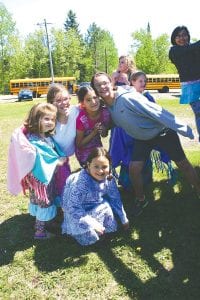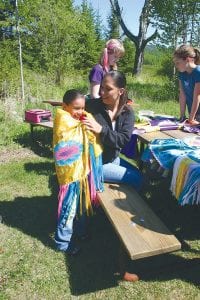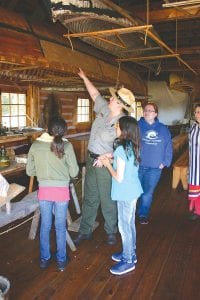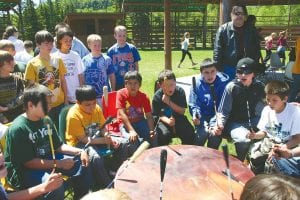Left: Fifth and sixth grade students from Oshki Ogimaag Community School and Sawtooth Elementary enjoyed an action packed day visiting Grand Portage National Monument and Grand Portage State Park and getting to know each other. Above: Students toured a workshop at the Monument that displayed boats and tools used by Indians and voyageurs during fur trading days.

The fifth and sixth grade students of Oshki Ogimaag Community School and Cook County Schools may have learned a lot on their end of school year field trip to Grand Portage National Monument and Grand Portage State Park on May 31, but they probably had so much fun they didn’t notice.
One of the things the students did was watch the movie Rendezvous with History: A Grand Portage Story at the national monument about the history of Grand Portage, focusing on roughly the last 300 years and how the fur trade changed the lives of the Objibwe, or Anishinabe, people forever.
The Anishinabe traded pelts for wool blankets, metal pots, and knives. This seemed like a good thing until the Europeans came and claimed the land, dividing it into Canada and the United States, Minnesota and Ontario and leaving the original people without most of the land they relied on for survival. Smallpox wiped out a generation of elders with the traditions and stories they would otherwise have passed down, furs went out of style in Europe, and the Anishinabe people were left without the livelihood that had carried them into new ways of surviving and interacting with the rest of the world. Their children were taken from them and sent to boarding schools, no longer allowed to speak their own language.
But they survived. And, as the film says, the Grand Portage National Monument was established “to preserve and protect our place, our story.”
It ends with individual photos of people who live there now.
Fleshing out this story were interpreters in the old fort walking the students past birch bark dwellings, playing bagpipes, explaining what went on in the great hall, and teaching old Native American games. Ranger Beth had the kids go pick up a rock from the shoreline and then line up across a field. Her instructions were, “Run as far as you can while screaming as loud as you can. When you can’t yell any longer and you need to take a breath, stop and put your rock on the ground.” The one who gets the farthest without cheating is the winner. What kids wouldn’t enjoy being told to run as fast as they can and scream as loud as they can?

Above left: Students on the field trip were shown the regalia worn by Native Americans at special events such as powwows. Above right: After a picnic lunch on the Grand Portage powwow grounds, the Little Eagles drumming group played while students danced around the circle. All of the students were warmly invited to participate.
At the Grand Portage State Park, students took a hike to High Falls and had a lesson on creatures of the north woods. Yvette Ibrahim, who is actually the Grand Portage Band of Chippewa air quality specialist, showed the students what was left of wolf scat after it was washed – bones and hair. “I have a really crappy job!” she said. She explained that each type of animal has a different pattern of scales on its hair follicles that can be identified in a microscope. She showed examples of fur taken from deer, moose, snowshoe hare and beaver, and the students were able to identify each type by sight.
Harvey Goodsky and Heather Hoaglund/LeGarde showed the regalia worn in traditional Native American ceremonies. Harvey said if he put all of his regalia on, it would weigh 55-60 pounds, “and I’d wear it all day for three days straight,” except for sleeping, he said. “If I wear these all day, my legs will be screaming at me all night.” Even the heavy bead earrings “kind of hurt after awhile,” he said.
A competitive dancer himself, Harvey named the three types of dances – traditional, fancy feather (men) and fancy shawl (women), and grass (men) and jingle dress (women) – and explained that dancers try to get their ankle bells to ring in rhythm with the drum beat during a powwow. “I try to the best of my ability to do it the right way,” he said, “and make it look good, too.”
The Native American students had an opportunity to welcome the others to Grand Portage and celebrate the gathering with drumming and dancing. Drumming was provided by the Stonebridge Drummers, an older youth drum group, and the Little Eagles, a younger youth drum group. Richard Vondall, who works for Oshki Ogimaag, said, “We’re here to understand the nature of our being and to protect the land,” and then he invited everyone to dance.
All that was just part of the day. The students at Oshki Ogimaag are likely to move on to Cook County Middle School in Grand Marais after completing sixth grade. Hopefully the field trip will help smooth a pathway of friendship and understanding among the students of Cook County.
(The students of Birch Grove Community School and Great Expectations School were also invited to participate in this field trip but were unable to attend.)




Loading Comments